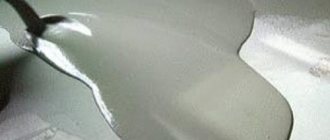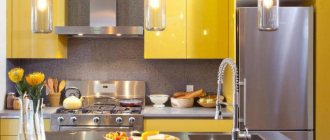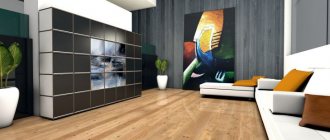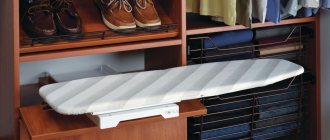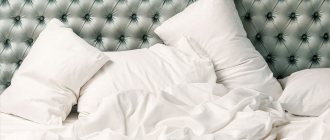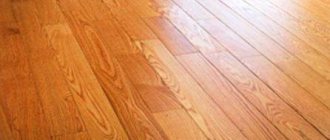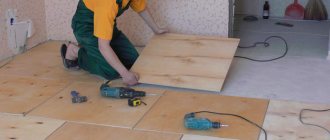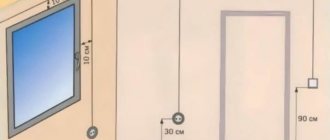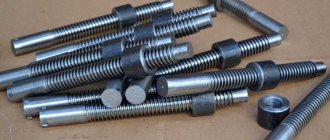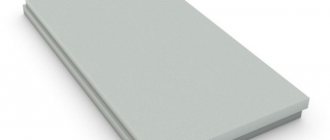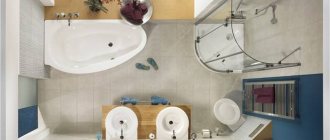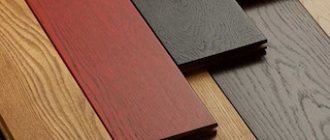As a rule, renovations in an apartment begin with replacing wooden floor coverings. More often than not, this all happens to be a solid wood floor. Of course, you can opt for porcelain stoneware or laminate. However, it is the wooden floor that has been and remains the most popular type of finish.
A properly chosen solid wood board will last a very long time and will require minimal maintenance. This is a natural material that can make any floor beautiful and comfortable. Therefore, you need to pay attention not only to the appearance, but also to the quality of this board.
Types of solid boards and their application
There are three main types of solid flooring boards:
- The most expensive and highest quality is the radial board. The main material for its production is oak. Most often this board is used in luxury interiors.
- When tangentially cut, a skeletal floor board is obtained. It has a uniform color and a clear wave-like pattern of annual rings. This type of floor covering belongs to the middle price category. This makes it the most popular.
- Natural This massive board may have knots and is characterized by sharp changes in color. According to its characteristics, it belongs to the most natural type of wooden floor. It can be safely used in an interior made in country style.
Wooden floor on concrete
The method of laying a floor on concrete is most often encountered, especially when it comes to a wooden floor in an apartment. Installation of a wooden floor is possible either on a concrete slab or on a poured base. It is very durable, but it is difficult to achieve a perfectly flat surface, so you will have to use adjustable floor technology or a joist structure. In this case, there are three ways to attach the logs:
- To the concrete base using self-tapping screws or dowels;
- Installation of a wooden floor on a metal corner;
- On a self-leveling floor.
Scheme of a wooden floor on joists on a concrete base
Massive board. Main varieties
In the production of solid flooring boards, exclusively natural wood is used. Outwardly it resembles parquet. Even the installation methods are similar. The groove-tenon fastening system allows you to obtain strength when connecting boards. Sometimes connecting boards using special brackets is used.
Of course, the price of a solid floorboard directly depends on the type of wood from which it is made. So, for rooms with high air humidity, it is best to finish the floors with boards made of oak or teak wood. An equally important characteristic of solid flooring boards is its strength and thermal insulation. They depend on the thickness. As a rule, the thickness of the board ranges from 100 to 200 mm. The length ranges from 500 to 3000 mm. When finishing rooms with a large area, 6-meter boards are often chosen.
Main varieties of solid boards:
- The highest grade includes floor boards, the surface of which is free of damage and knots. In principle, this is a completely finished floor. To protect the surface of a wooden floor, use water-based varnish or special wax.
- A first grade board may have a small number of small knots. However, the appearance does not suffer from this. This building material is completely suitable for use as a wooden floor.
- Second grade. Large knots may be present. As a rule, the purpose of such a massive board is to paint the floor.
- The lowest grade for flooring is grade three. Such a board may have significant flaws and even be curvature. It is mainly used when installing a subfloor, for further finishing of solid boards.
What is a floorboard?
If you decide to install a wooden floor in your home, you should consider the characteristics of the specific type of board, its grade and thickness, as well as what types of floors it can be used for.
To prevent the floor from deteriorating in the near future, the boards from drying out and starting to creak, the thickness of the floorboard must be selected correctly. In particular, this parameter, as well as the linear dimensions and design in general, will be decisive for creating a high-quality floor. There are four types of wood available to the buyer:
- Highest grade - such boards are free of knots. The floor from them will be truly beautiful, especially without painting. This way, the natural color and texture will be preserved, and the floor can be covered with a special varnish, oil or wax.
- 1st grade – this material has a few small light knots. Once opened with varnish or wax, this board will look pretty good.
- 2nd grade - on such boards you can find slightly larger darkish knots. In addition, there are more of them in number. It is better to paint such floors.
- 3rd grade - abounds in knots, the boards may be bent. Most often, this material is used for rough covering or for laying the main floor in sheds and utility rooms.
A board made of natural wood can be 25-60 mm thick. In rooms with lags spaced 400-600 mm apart, it would be advisable to use a board 30-35 mm thick. If there are 700 mm between the lags, then the board should be thicker, at least 40-60 mm. A wide floorboard will also work.
When deciding which boards are needed for the floor, you should consider the following:
- You need to choose dry boards.
- Dry wood has a ringing sound, you need to focus on this.
- The surface of the board must be perfectly flat, including its edges. Deformed boards will be very difficult to install.
- The wood must be of a natural shade, without blue or white bloom, otherwise it will quickly deteriorate.
The tongue and groove floorboard should have a groove and a tenon located at different ends. High-quality types of such boards are equipped with grooves on the bottom for ventilation, usually 2-3 of them.
A floorboard is a profile part made of wood, which is intended for covering the floor. Externally, it looks like a milled board, which is made of a massive piece of wood. This, by the way, is the main difference between a floorboard and a parquet, since the latter is obtained by gluing together several thin layers.
To ensure that the boards adhere tightly to each other, each of them has a groove (on one edge) and a ridge on the opposite.
It is obvious that the material from which the floorboards are made is exclusively natural wood. Moreover, it must be high quality wood - without flaws, knots, blackening or cracks. Thanks to the natural material, floorboards are an environmentally friendly floor covering that is not capable of causing allergies.
The most suitable material for making floorboards is oak, ash, larch and pine wood. Walnut, alder and aspen are used a little less frequently, since these species are not hard enough. An extremely undesirable material for making floorboards is wood from species such as poplar or linden.
Like any other type of flooring, floorboards have several distinctive characteristics. Among them are the following:
- the strength and reliability of the material (this is a very important feature, since this type of lumber constantly experiences heavy loads);
- durability of the material (an important characteristic determined, first of all, by the quality and type of wood from which the board is made);
- fairly high rates of heat and sound insulation;
- high resistance to deformation;
- environmental friendliness and safety of the material.
Advantages of floorboards
Floorboards have a considerable list of advantages. which follow from its technical characteristics:
- the board floor is based on natural material;
- strength and reliability;
- excellent thermal insulation;
- environmental friendliness of the coating;
- antiallergic properties;
- durability of the material;
- aesthetic appearance;
- relatively low cost.
In addition, plank flooring is a great way to decorate the interior of your home. make it as warm and homely as possible.
Disadvantages of floorboards
However, floorboards also have their disadvantages. among which:
- difficulty in maintaining the floor from the boards;
- predisposition to rubbing and the appearance of scratches and dents;
- the material is flammable;
- subject to rotting processes;
- can change its shape over time;
- the possibility of gaps appearing between the boards due to changes in their volumes in winter and summer.
The parameters of the floorboard include its width, length and thickness. The most important size of a floorboard is its width.
Today you can find floorboards from 80 to 135 mm wide on sale. The standard parameters for the thickness of the floorboard are the following: 28, 30, 32, 35 and 40 mm. The length of the floorboards can be 3, 4, 4.5 or 6 meters.
As practical experience shows, the most popular size board is 100−105 mm wide and 30−35 mm thick.
When choosing the width of the floorboard, you must first take into account the overall design of the room. After all, a floorboard that is too narrow (or, conversely, too wide) will not fit into any interior.
When choosing the thickness of the board, you need to proceed from the distance between the logs for laying them. If the distance between adjacent logs exceeds 70 cm, then you should choose boards with a greater thickness.
First of all, it is important to decide for what purpose the board will be used. If you need a board to make a subfloor. then you need to choose one that has no flaws, warping or rotten knots. Boards for organizing the finishing floor must have a stable geometry and absolutely no knots.
You also need to take responsibility when choosing the thickness of the boards. The minimum thickness of the floorboard should be 21-22 mm. Obviously, the choice of the thickness of the floorboard should be determined by the loads that your floor will feel.
Much attention should be paid to the quality of the wood. from which the board is made. The following parameters are important here:
- type of cut;
- presence of knots and cracks;
- percentage of material warping.
In practice, there are two main ways to lay floorboards:
- The so-called “parquet” method, when boards are laid on a flat surface using glue.
- Laying floorboards on joists.
This method is often called “parquet”, since the process of laying floorboards here is similar to the process of laying regular parquet. The only difference is that the floorboards, due to their considerable thickness, are additionally secured with self-tapping screws.
To use this method of installing floorboards, it is necessary that both the surface and the boards themselves are perfectly flat. The important point here is the correct choice of glue. In principle, any glue will do: epoxy, dispersed or polyurethane. However, if the floorboards are made of exotic wood species (such as, for example, beech), then it is better not to use dispersed glue. The glue must be strong and, at the same time, flexible. One- and two-component polyurethane adhesives are quite suitable for these purposes.
If your house has wooden floors between floors, or you need to lay the floor in a room with a high ceiling, then it is better to use this installation method.
First you need to install the so-called logs, at a distance of 60-70 cm between them. A wooden beam with a cross-section of 50−70 mm is used as floor joists. The logs must be treated with some kind of antiseptic.
As sound insulation for floorboards, you can use expanded clay floor screed or lay mineral wool. And in order to get rid of the “drum effect” as much as possible, you need to lay glassine or synthetic padding in the space between the boards and joists.
Next, the process of directly laying the floorboards begins. Typically, floorboards are laid with the ridge forward. The first board is fastened in such a way that the screws overlap the wooden floor plinth.
The last stage of laying a plank floor should be sanding and then varnishing the finished floor. You need to sand the floorboards first across, and then along and diagonally. To varnish the floor, it is recommended to use a high-strength varnish. Varnish on floorboards must be applied in at least two layers.
So, plank flooring will undoubtedly make your home more comfortable and pleasant. Floorboards are an ideal, time-tested material that is durable, beautiful, stylish and environmentally friendly.
Morozova Elsa
Choosing a floorboard is a process that should be taken seriously. When purchasing a rough or fine coating, you should take into account a number of necessary characteristics: quality, type of wood and dimensions of the board. The service life of the floor depends on how well the material is selected. After all, it bears the main mechanical load.
There are several parameters by which wood flooring is selected. The dimensions of the floorboard are not the last thing to choose. This characteristic depends on the following factors:
- place of use (residential premises, outbuildings, street, verandas);
- what kind of coating it is (rough or finishing);
- load on the planned floor layer.
The length is selected based on the parameters of the premises so that there is a minimum number of joints and waste. Fortunately, the building materials market allows this to be done. The existing size range is 2, 3, 4, 6 m.
The choice of floorboard thickness depends on the intensity of use and the distance between the joists. The higher it is, the thicker the board will be required. For example, if the distance is up to 700 mm, then it is better to choose a board thickness of 35–40 mm, above this size – 40–50 mm.
This process can be broken down into several stages:
- Installation of logs;
- Waterproofing. insulation of underground space;
- Installation of the finishing coating.
Wooden coverings will require the installation of ventilation holes (vents). At the first stage, it is important to determine the distance between the lags. It is better if it is 600 mm. The logs are laid across the length of the boards. It will be easier to lay the floor if the timber is laid out level.
The second stage allows you to organize additional thermal insulation and protection from moisture.
What kind of wood is the board made from?
When choosing a solid board for the floor, you need to pay attention to what kind of wood it is made of. The fact is that there are several very specific characteristics. Moreover, each type of array can have a different texture and color scheme. Therefore, the floors will turn out different. Therefore, the board can be selected taking into account the characteristics of the room.
- Oak. This floorboard has the highest strength indicators. Moreover, it is quite easy to process. This tree contains hydrocyanic acid in large quantities, so solid oak boards are practically not susceptible to rotting and attack by pests. An oak floor can be coated with oil, in which case it will have a rich color. A large selection of colors from light brown to dark allows you to choose the material depending on the style of interior design. Solid oak wood has a high cost, which in this case is completely justified.
- Wooden boards made from walnut are also very elite. Its texture is close to oak, but there is a wide choice of textures. It is highly brittle and prone to cracking. This tree has disadvantages - moderate resistance to pests and rot. However, flooring is rarely made from it due to its high cost. Most often it is used in the manufacture and finishing of furniture.
- Solid ash has a pleasant yellowish tint and pronounced texture. A floor made from such wood is durable and has good density. It is resistant to deformation and rotting. The disadvantages include the tendency to crack if the drying technology is violated. However, the board is suitable for the floor.
- If you make a wooden floor using solid larch boards, it will be durable. Such wood is little susceptible to rotting, is not affected by fungi, and has antiseptic properties. Covering the floor with larch will give the room lightness and fill it with a pleasant aroma of pine needles.
- The floor made from solid wenge boards looks very attractive. Thanks to the rich color range from chocolate to almost black, it will fit into almost any interior and make it slightly exotic. However, wenge is not very suitable for flooring. It does not differ in wear resistance and strength. Therefore, this floor will require maintenance over time.
- In many interiors today you can even find bamboo floors. However, it is not complete. It is glued together in a special way from thin strips of wood. The golden-straw shade is quite suitable for the living room, nursery, or bedroom. The board is appropriate in an ethnic interior. It is wear resistant.
Thickness of the board for the floor in the bathhouse. Which boards to choose for flooring
For the floor in the bathhouse, you can use boards made from hard deciduous or coniferous trees. It is important that the material is not affected by tree diseases or damaged by insects. In addition, you should pay attention to the degree of drying of the material; wet boards are more susceptible to deformation. Considering the peculiarities of using bathhouses, it is advisable to use deciduous trees, they accumulate and release heat better. All boards that will be used for the construction of floors and joists should be treated with protective compounds. These impregnations should not emit vapors at high temperatures. In central Russia, the optimal choice would be floors made of oak planks.
Despite the relatively high cost, there will be clear savings in the future due to the long service life. If it is not possible to use oak boards, then ash or beech will do. Of the coniferous species, pine or larch, as well as cedar, can be used on the floors.
Size and quantity of material for wooden floor
- Boards - optimally, use boards with a thickness of 30 to 40 mm, the width can range from 80 to 150 mm. The quantity is calculated taking into account the total area of the room and the width of each board.
- Logs are laid across the room, so the length of the beam must be calculated according to the width of the room. Depending on the size of the room, timber with a cross-section from 110x60 mm to 220x180 mm is used. The distance between them is determined by the thickness of the floorboards, it can be from 30 to 100 cm. For the steam room, under the place where the stove will be installed, the distance between the logs should be from 20 to 40 centimeters, here the size and total weight of the stove itself must be taken into account . For the reliability of the structure in such places, it is recommended to install additional support made of brick or concrete. For example, under boards forty centimeters thick, logs must be laid at a distance of from forty to 40-60 centimeters.
How to choose the right solid board
A wide selection of boards made from different types of wood allows you to choose them for different interiors. However, not only the appearance of the wood is important, but also the quality of the material. Therefore, when choosing an array for floor renovation in an apartment or house, you need to pay attention to the following parameters:
- Array variety;
- Good appearance;
- There is no external damage or signs of rotting of the array;
- In this case, solid boards should be slightly damp. Too dry ones are considered defective. In order to determine the quality, you need to touch the cut in the middle;
- You can knock. If the sound is clear, then the quality of the array is good and can be purchased;
- If a floorboard is chosen for an apartment or house, then it must be flat. Otherwise, installation difficulties will arise;
- The even color of a solid board with smooth transitions indicates its durability.
How to choose the right engineering board
Engineered boards are widely used due to their high technical properties, affordable price, variety of shades and decors, as well as simple installation. The material can withstand repeated scraping and does not lose its shape or attractive appearance. Which engineered board to choose for an apartment? To ensure that the purchased products meet all your expectations, pay attention to the following features:
- integrity of the goods. There should be no chips between the lamellas; their presence indicates excessive dampness of the material;
- the thickness of the outer layer of the engineering coating (ranges from 2 to 6.2 mm). The higher this indicator, the longer the panels will last, they can be sanded more often;
- type of wood. The most wear-resistant and resistant to mechanical damage boards are made from oak, American walnut, ash, beech or teak;
- plank format. The standard lamella format is an elongated rectangle with smooth edges. But some European manufacturers offer a more original option - a curved board of various sizes with grooved locks cut at the ends. This flooring looks incredibly stylish and original;
- laying method. If you want to quickly complete the installation of lamellas, choose products with a locking connection, the presence of which implies the use of a floating installation method.
Well, don’t forget about the pattern on the surface of the panels. Standard boards with a pronounced longitudinal natural pattern will visually elongate the premises. If you want to zone rooms using engineered boards, give preference to a material that has chamfered transitions.
Some nuances of producing solid wood boards
In order for a wooden floor to be truly high-quality and durable, the material must be chosen correctly.
How to make a solid board:
- The wood mass is used for harvesting;
- It is pre-dried;
- Cut into lamellas.
The optimal thickness of a solid board according to European standards should be at least 20 mm, width from 125 mm to 190. Its standard length is 1800 mm. Today in construction markets you can find solid boards made in China. The boards vary in thickness, width and length. Typically, the length of Chinese boards is about 1200 mm. This board is only good as a temporary option, for example, for a living room.
It is worth paying attention to the impregnation of the array. It should be based on natural oils, not toxic varnishes.
Straw house
I initially had only one plan for flooring in our thatched house: only solid wood floors. The “pie” should consist of a subfloor, covering material, insulation and then the finished floor. How I chose the floorboard and what I learned about it in the process - read on...
For those interested in learning about the roof and roofing accessories, read the section “Roof of a thatched house.” Here are the questions that arose in my mind about the floorboard and to which I found the answer. The first question is the simplest.
Solid floor boards: pros and cons
To be honest, solid boards have always attracted me: here you have environmental friendliness, easy tongue-and-groove fastening, low thermal conductivity, and noise insulation. All over the world it is considered super; in Sweden, for example, almost the majority of apartments in cities have wooden floors, and this is what is considered the norm, and not some kind of laminate.
The only drawback (or rather, even doubt) for me is still the softness of pine boards - and it is the most common one. Any blow to it immediately causes a dent. If you paint with paint, the probability is less, of course, but you want to use varnish and have it shine forever... :))
True, as practice has shown, another difficulty - especially in comparison with some kind of laminate or linoleum - is laying a wooden board without available tools. I once wrote about Bowrench - so, if it weren’t for him, pulling together deformed boards would have been sooooo stressful. The process, even with the tool, turned out to be quite long.
What types of solid flooring are there?
With varieties, everything is simple: they are designated by the letters A, B, C. There can also be combinations of letters like AB, BC.
One difference is the presence of knots. On a grade A floorboard there should be very few of them (several pieces per 1 square meter) and no more than 3 mm in diameter. Sometimes this variety is also called “Extra”, but it’s like with strawberries at the market - one of the sellers will take the time to find and select beautiful boards, stack them, and so the price immediately goes up. Grade B allows knots up to 10 mm in diameter on the surface. Grade C allows for loose knots and various defects.
Which floorboard is the cheapest is clear - this is, of course, grade C. It is usually taken only for painting, meaning opaque. If you want to varnish or impregnate with stain, of course you need to take a better variety.
If I'm not mistaken, the solid floor board is 27 mm thick, grade BC (knots and defects are visible even in the photo)
Personally, I bought AB at a discount for the first floor, and grade BC for paint for the attic floors.
What board thickness should I choose for the floor?
The thickness must be determined based on the distance between your beams/joists. The larger it is, the thicker the board should be. For example, more than 60 cm is definitely forty (40 mm). In attics, where the distance between the beams is usually large, it is usually installed. At the bottom, in most cases, 27 mm or 35 mm is enough.
My entire floorboard is 35mm.
What size floorboard should I take?
The most common sizes are 3 and 6 meters long, 27 mm thick, 123 mm wide. However, you can find almost any floorboard in length. Many sellers even offer to cut it on site, but I wouldn’t risk it :)
We calculate how many floor boards to buy
I have a floor board 4 and 5 meters long. As practice has shown, even three meters would be enough for my floors.
What type of board should be used for the subfloor?
For the subfloor, take the cheapest options. This is either grade C or a regular board, and some even put the unedged board down. It is clear that in the last two cases there are gaps between the boards and they need to be sealed somehow so that the wind does not whistle.
I personally made the subfloor with just an ordinary edged board, then laid down black spunbond, then placed bars, and between them I poured ecowool as insulation, after which I laid the finished floor. I’ll probably write about the subfloor separately, because... I made one mistake with him...
How to choose a floor board from a seller?
Also reading with this post:
- How I remembered how I doubted what...
- How to bring water into the house? List of questions to...
How to calculate finances when buying a board
Of course, everyone wants to save at least a little on repairs. Therefore, when choosing a board, you need to take into account the following factors:
- What kind of wood is the solid board made of? The most beautiful, durable and wear-resistant board is oak board. The approximate cost can be from 1,700 to 6,000 rubles per square meter. Solid bamboo boards are no less popular today. It is also considered to be very wear-resistant. In terms of cost, it is more expensive than oak, from 2300 to 5000 per square.
- If you choose a board with an aging effect, its cost will be even more expensive.
The high cost of the board is justified by the fact that it is a natural material. With proper installation and care, a solid board will last for decades. Therefore, the investment will be fully justified. Don’t forget that environmentally friendly boards help preserve the health of the apartment owner and his family. What is no less important.
More information about solid boards
Solid wood is a floor board made from solid wood. While, for example, parquet boards have a layered structure and are assembled from various types of wood. Modern methods of drying and making floorboards make it possible to produce a material that is radically different from the wooden flooring used in earlier times.
If previously the floorboard was attached to the base with nails, then modern floorboards are usually tongue-and-groove. It has a so-called locking fastening, i.e. on one side there is a groove, and on the other there is a tongue (tenon). This allows you to create a single sheet of floorboards without any movement gaps when laying the floorboard. After all, the boards adhere firmly to each other and fit perfectly together.
The cost of modern floorboards is quite high. But such a floor does not require additional covering with linoleum, carpet or other synthetic material. The main thing is to choose the right flooring board. In this case, you should focus on the characteristics and purpose of the room or premises. For rooms with high air humidity, you should purchase floorboards only from types of wood with a dense structure such as palacho, keppas, oak or teak.
In rooms with extremely dry air or high humidity, do not lay boards made from fruit trees, especially light-colored ones.
Floor board, tongue and groove, has the following dimensions:
- thickness – from 1.8 to 6 cm;
- width – from 10 to 20 cm;
- length – from 50 to 300 cm.
The thickness of the solid board is responsible for its strength and sound insulation of the room. The range of sizes allows you to accurately select the material and lay it without problems and losses in rooms of any size.
What if you choose a parquet board?
An equally interesting floor covering is massive parquet boards. This finishing material is also made from solid wood. Such floors have a number of unique qualities that are unique to them.
- This is a completely natural material, without any components;
- To refresh the floor, it is enough to sand the boards (up to 6 times);
- An interesting color scheme and beautiful solid texture allow you to choose a parquet board to suit any interior.
- Excellent heat and sound insulation of the board. This is especially true in apartment buildings.
- The durability of parquet boards is also another advantage.
A wooden floor made from such an array looks very rich and beautiful. If the parquet is installed correctly using glue, excellent adhesion to the base is obtained. Disadvantages include high cost and poor resistance to air humidity.
In winter, cracks may form on parquet floors due to low air humidity, which disappear in summer. However, such problems can be avoided if you purchase special air humidifiers for your room.
How to level floor boards?
If the problem of an uneven floor arises, it can be solved in several ways.
The most labor-intensive is leveling the surface using a plane. Using a sander will make your work easier and easier. You can do the scraping yourself, or you can invite a specialist.
The easiest way is to cover the laid parts with an additional coating: sheets of thick plywood, chipboard. This is especially true before laying linoleum or laying laminate.
Sometimes a finishing leveling mixture is used to level the floor. But if your coating has a large difference in height, using such a mixture is pointless.
